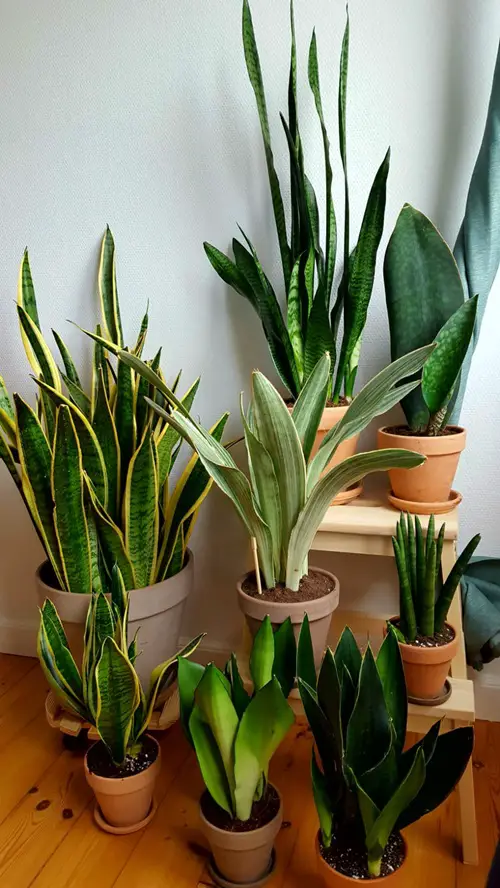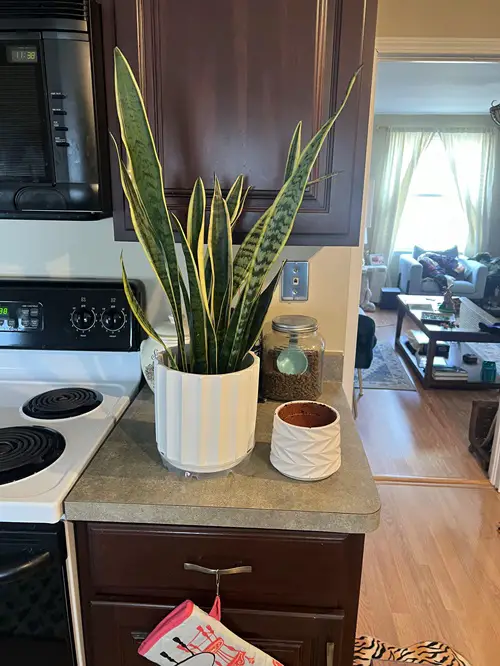Fact or fiction? Let’s test popular claims about this classic houseplant and uncover the truth behind common snake plant myths!

This iconic houseplant’s reputation is as sharp as its sword-like leaves! From purifying air to thriving in total darkness, there’s always some buzz around it—but what is fact, and what is pure fiction? Let’s debunk common snake plant myths one by one!
Common Snake Plant Myths Debunked
Myth 1: Snake Plants Are Always Green
Green might be the dominant shade in most snake plants, but it is hardly the one to define its versatile foliage by! Featuring stunning patterns and textures, snake plant varieties are too dynamic to be pigeonholed.
The Sansevieria trifasciata ‘Laurentii’ has yellow borders, and Sansevieria Moonshine has silver-green leaves. Each variety has its own identity, which goes far beyond a classic green. If you need more convincing, check out these variegated snake plants!
Myth 2: They Thrive On Neglect

Allowing something to breathe is not necessarily neglecting it! Sure, the snake plant is hardy and grows relatively fuss-free, but that doesn’t give you a free pass to abandon its survival to chance!
Like most living things, your Sansevieria needs water, light, and nutrients to thrive. Keep it in a spot that receives dappled sunshine, and here’s how to water your snake plants.
Myth 3: Snake Plants Grow in Complete Darkness

Light is essential for photosynthesis. Some may need more and some less, but all plants need light to survive. So when you see claims about how your snake plant will flourish in complete darkness, that myth has to go!
Snake plants need bright, filtered light to flourish but can tolerate low-light conditions. The problems begin when gardeners believe it will grow better in low light. Do not stick them in a dark room and wonder why it’s dying!
Now, if you don’t get enough natural sunshine in your home, here are a few things you can do as light alternatives for Sansevieria and other plants.
Myth 4: Snake Plants Do Not Flower

Surprise! While infrequent, snake plants push out tiny, fragrant white blooms under certain circumstances. If you want your snake plant to bloom, buy a mature specimen, keep it root-bound, and give it a lot of sunlight.
Try doing it with these flowering snake plant varieties to increase your chances.
Myth 5: Overstating Their Air Purifying Qualities

You can’t just stick a tiny potted snake plant in your bedroom and think your indoor air is crystal clear! Everyone points to a claim that NASA stated having 6-8 snake plants in a room without airflow is enough for human survival.
Well, NASA itself has clarified that it never did a study on numbers. The agency’s clean air studies pointed to certain houseplants’ ability to improve air quality and reduce certain toxins, along with other potential benefits, but not how many of them.
However, it may be true that surrounding yourself with 15-18 snake plants can increase the air quality of a room.
Myth 6: Snake Plants Produce Oxygen All Night Long
While it’s true that snake plants are known for releasing oxygen at night, this is not an exclusive feature of the plant, nor does it mean they produce oxygen continuously throughout the night.
Snake plants can perform Crassulacean Acid Metabolism (CAM). During the day, they close their stomata to conserve water and open them at night to store CO2 as an organic acid. The next day, they use this acid for photosynthesis.
Snake plants release a small amount of oxygen at night, but not in quantities that significantly affect indoor air quality or replace air purifiers or ventilation systems.
Myth 7: Snake Plants are Poisonous to Pets
Snake plants contain saponins that can harm pets, but only if they consume a lot. Saponins can cause temporary tummy troubles like vomiting and diarrhea but are not usually life-threatening.
It’s best to keep snake plants away from pets, especially curious kittens and puppies. If you think your pet has eaten a snake plant, watch it closely for signs of illness. If it gets serious, take it to the vet.
Remember, a little snake plant won’t hurt your pet. It’s when they eat a lot that it becomes a problem.
Myth 8: Snake Plants Bring Bad Luck

The myth surrounding snake plants being lousy luck stems from their distinctive appearance. Their spiky, sword-like leaves can give off a somewhat intimidating vibe, leading some to associate them with negative energy.
Of course, this belief lacks any scientific foundation. Many cultures view snake plants as having positive symbolism. In Feng Shui, for example, they are often associated with longevity and prosperity.
The plant’s ability to tolerate low light and purify the air further fortifies why you should grow it. And from a symbolic point of view, snake plant flowers have meaning, too!


